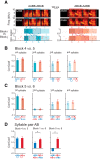Neuronal Encoding in a High-Level Auditory Area: From Sequential Order of Elements to Grammatical Structure
- PMID: 31147525
- PMCID: PMC6668201
- DOI: 10.1523/JNEUROSCI.2767-18.2019
Neuronal Encoding in a High-Level Auditory Area: From Sequential Order of Elements to Grammatical Structure
Abstract
Sensitivity to the sequential structure of communication sounds is fundamental not only for language comprehension in humans but also for song recognition in songbirds. By quantifying single-unit responses, we first assessed whether the sequential order of song elements, called syllables, in conspecific songs is encoded in a secondary auditory cortex-like region of the zebra finch brain. Based on a habituation/dishabituation paradigm, we show that, after multiple repetitions of the same conspecific song, rearranging syllable order reinstated strong responses. A large proportion of neurons showed sensitivity to song context in which syllables occurred providing support for the nonlinear processing of syllable sequences. Sensitivity to the temporal order of items within a sequence should enable learning its underlying structure, an ability considered a core mechanism of the human language faculty. We show that repetitions of songs that were ordered according to a specific grammatical structure (i.e., ABAB or AABB structures; A and B denoting song syllables) led to different responses in both anesthetized and awake birds. Once responses were decreased due to song repetitions, the transition from one structure to the other could affect the firing rates and/or the spike patterns. Our results suggest that detection was based on local differences rather than encoding of the global song structure as a whole. Our study demonstrates that a high-level auditory region provides neuronal mechanisms to help discriminate stimuli that differ in their sequential structure.SIGNIFICANCE STATEMENT Sequence processing has been proposed as a potential precursor of language syntax. As a sequencing operation, the encoding of the temporal order of items within a sequence may help in recognition of relationships between adjacent items and in learning the underlying structure. Taking advantage of the stimulus-specific adaptation phenomenon observed in a high-level auditory region of the zebra finch brain, we addressed this question at the neuronal level. Reordering elements within conspecific songs reinstated robust responses. Neurons also detected changes in the structure of artificial songs, and this detection depended on local transitions between adjacent or nonadjacent syllables. These findings establish the songbird as a model system for deciphering the mechanisms underlying sequence processing at the single-cell level.
Keywords: artificial grammar; auditory perception; multielectrode; sequence; songbirds.
Copyright © 2019 the authors.
Figures











References
Publication types
MeSH terms
LinkOut - more resources
Full Text Sources
Research Materials
